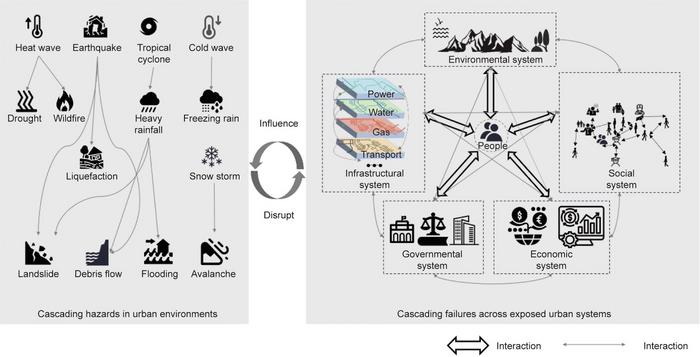As urbanization continues to escalate alongside the growing threats posed by climate change, cities around the globe are grappling with an increasing array of coupled risks. The interplay of urban life and environmental vulnerabilities has become an urgent topic of discussion among researchers and city planners. In a groundbreaking article published in the journal Engineering, Min Ouyang and his team delve into the intricate nature of these risks, offering a fresh perspective on the dynamics that underpin urban resilience and sustainability.
The concept of coupled risks is complex, suggests the paper, as it attributes vulnerabilities to the compounding effects of various interacting uncertainties. Disruptions within one subsystem of an urban environment can not only precipitate immediate damage but can also trigger a cascade of effects across interconnected systems. The aftermath of an extreme weather event, for instance, can cripple infrastructure, impede socioeconomic activities, disrupt governance structures, and adversely affect environmental quality. The multifaceted nature of these interactions emphasizes the need for a comprehensive understanding of urban risks and their management.
A key challenge facing current risk assessment models is their inability to adequately capture the intricacies inherent to compounded urban risks, particularly when considering human decision-making processes. Traditional models may overlook critical social dynamics or fail to account for the way people interact with urban systems. To bridge this gap, Ouyang and colleagues propose four core perspectives that aim to enhance the understanding and management of urban risks.
The first of these perspectives advocates for the development of a standardized taxonomy that explicitly categorizes cascading hazards, urban components, and their interrelations. This taxonomy should emphasize a human-centric approach, reflecting the crucial bidirectional nature of interactions between people and urban environments. By fostering a clearer understanding of how risks disseminate, such a standardized classification could be instrumental in refining risk assessments while also improving early warning systems.
Moreover, the researchers underscore the necessity for an integrated risk assessment framework that prioritizes human considerations. This framework should encapsulate not just infrastructural and environmental dimensions, but also economic and social aspects, alongside individual decision-making behaviors. While agent-based modeling represents a promising tool, it is imperative that these models adhere to a uniform taxonomy and effectively incorporate the hierarchical needs of individuals during crises.
Data integration emerged as a third significant recommendation. The authors point out that, although a plethora of data sources exists in our hyper-connected era, each source typically possesses particular limitations. By synthesizing diverse data platforms—ranging from social media insights to satellite imagery and official reports—and implementing advanced data-mining techniques, researchers could yield models that are not only more accurate but also better tailored to account for the complex realities of urban systems. A continuous updating process will be essential to adapt these models to the ever-evolving dynamics of urban life.
The final perspective highlighted in the research speaks to the importance of adopting people-centric strategies that empower communities. These strategies can be categorized into two primary areas: promoting individual engagement in risk reduction and ensuring that communities receive timely information and educational resources. By fostering a culture of proactive engagement among citizens regarding their role in risk management, cities can cultivate resilience within their populations.
The significance of these perspectives goes beyond mere theoretical exercises; they hold the potential to inform practical solutions to urban risk management challenges. However, the paper notes that empirical case studies are essential for translating theoretical frameworks into actionable strategies. The integration of cutting-edge technologies, such as artificial intelligence and digital twins, could play a crucial role in refining the modeling and validation processes associated with risk assessment frameworks.
Transitioning these innovative ideas into practical applications necessitates a structured, systematic roadmap. Such a plan could give rise to a nascent interdisciplinary field known as “urban risk science,” which might assume a vital role in the study of urban risks. This research not only advances academic discourse but may also contribute significantly to enhancing urban resilience, aligning with the broader framework of the United Nations’ Sustainable Development Goals.
Ultimately, the study presented by Ouyang and his team represents a call to action for researchers, policymakers, and urban planners alike. The pressing need for cities to adapt their strategies in response to multifaceted risks cannot be overstated, as urban environments increasingly face pressures from climate change and rising populations. The innovative perspectives put forth in this research could serve as a foundation for more resilient urban living conditions today and in the future, as cities strive to become bastions of sustainability and safety amid an ever-changing landscape of risks.
The implications of this research extend far beyond academic circles; they resonate with community stakeholders and policymakers who must navigate the complexities of modern urban life. The proposed methodologies and frameworks hold the potential to redefine how cities approach risk, ultimately leading toward a more cohesive and responsive urban ecosystem. Through thoughtful integration of social, environmental, and infrastructural insights, cities can enhance their resilience in the face of growing uncertainties, ensuring they are prepared to meet the challenges of tomorrow.
With the increasing urgency to address these coupled risks, the work of Ouyang et al. prompts a fundamental shift in how we perceive urban threats and prepare for future crises. As cities evolve, the pursuit of innovative, people-focused risk management strategies becomes essential. The need for comprehensive, interdisciplinary approaches is clear, and the establishment of a framework for urban risk science may very well lead us toward more prepared and resilient urban environments.
Subject of Research: Understanding and managing coupled urban risks under climate change.
Article Title: Coupled Urban Risks: A Complex Systems Perspective with a People-Centric Focus.
News Publication Date: December 27, 2024.
Web References: https://doi.org/10.1016/j.eng.2024.12.023.
References: None provided.
Image Credits: Min Ouyang et al.
Tags: adaptive strategies for urban resilienceclimate change urban riskscomplex systems approach in urban planningcompounded risks in urban ecosystemsdecision-making in urban risk assessmentgovernance challenges in urban environmentsinfrastructure resilience in citiesinnovative urban sustainability solutionsinterconnected urban vulnerabilitiespeople-centric urban risk managementsocioeconomic impacts of urban disruptionsurban resilience strategies





